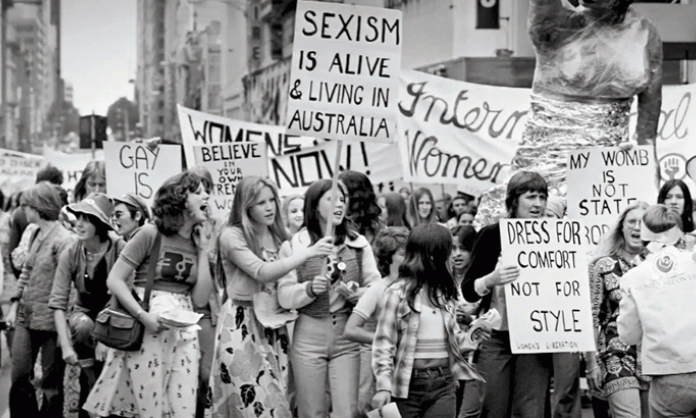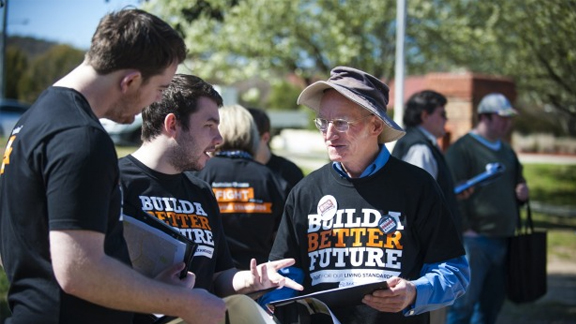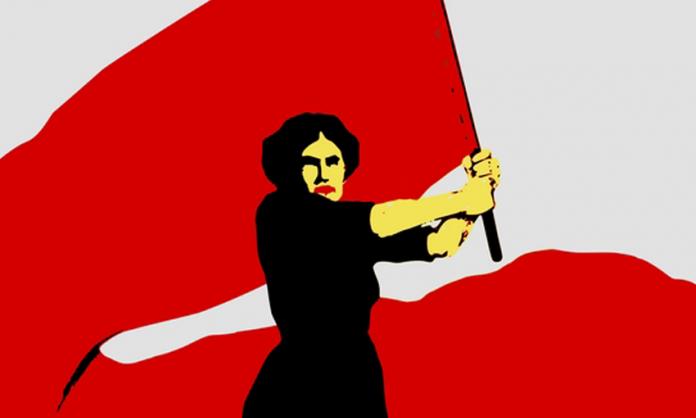International Women’s Day has become mainstream in recent years. But historically it was a socialist event. Clara Zetkin, a leading member of the German Social Democratic Party (SDP) in the early 1900s, argued that the working class would never win its battles without women and raised the issue of special party work among women. Under her leadership, a working women’s movement grew rapidly in Germany, and the female membership of the SPD rose from 10,500 in 1907 to 150,000 in 1913.
Zetkin proposed the establishment of an international working women’s day at the International Socialist Women’s Conference in Copenhagen in August 1910, inspired by US socialists who had held women’s demonstrations and meetings the year before. The slogan for IWD was to be: “The vote for women will unite our strength in the struggle for socialism.”
In 1911, more than a million women and men took up the idea of IWD enthusiastically in rallies and marches, described by the leading Russian Bolshevik Alexandra Kollontai as “one seething, trembling sea of women”.
In subsequent years and throughout First World War, IWD continued to provide a focus for activists. What happened in Russia in February 1917 is famous. In spite of all opposition, women in Petrograd chose to protest and strike for “Bread and Peace” on 23 February, and with this sparked the February revolution.
In Australia
The history of IWD in Australia is not so well known.
The first celebrations were organised by the Militant Women’s Group (MWG), set up by the Communist Party following its establishment of a central women’s department in 1927. The group was first established in Sydney and later spread to country NSW, Brisbane and Melbourne. It published a monthly newspaper, Woman Worker.
The MWG organised a rally in the Sydney Domain on 25 March 1928. The demands were an eight-hour day for female shop workers, no piece work, the basic wage for the unemployed and annual holidays on full pay. The Sydney MWG again organised a public meeting for IWD in Belmore Park in 1929 – this time with a focus on support for the wives and families of striking timber workers.
The first Melbourne event occurred in 1931. With the lead banner proclaiming “Long live International Women’s Day”, 50 women led 150 men on a march to the Yarra Bank.
The MWG was the beginning of an important network among women party members and others around them. Here is a quick glimpse of some of the women activists of the day, for whom International Women’s Day was an annual celebration.
Jean Young was involved with the unemployed movement in the early 1930s and a member of the CPA. As a barmaid, she was active in the Liquor Trades Union in Melbourne and became its first elected female organiser. The union executive initially restricted her from organising hotels because they “weren’t suitable places for women to enter”.
Jean managed to convince them to charge women a lower union membership fee because they had lower wages, and to adopt a policy of equal pay. She successfully organised many hotels and restaurants, including the Parliament House refreshment room.
Anna Morgan, an Aboriginal woman, spoke at the 1934 Melbourne IWD rally, where she denounced the “black flag of the Aboriginal Protection Board” and called for legal changes and access to social welfare for Aborigines. Anna was born in 1874 at a mission station in north-west Victoria and became a domestic servant at the age of 11. Her husband’s family had been allocated a farm block at Cumeroogunga on the Murray in 1888, but the Aboriginal Protection Board revoked the agreement in 1907. When Anna and her husband refused to accept this, they were expelled from the station and charged with trespass, lost many possessions and were jailed when they tried to retrieve them.
Gloves and banners
In the late 1930s and the war years, IWD involved a broader range of participants, but it also became more conservative and conventional in its approach. The atmosphere of militancy and direct action waned, and the day was mainly celebrated with luncheons and afternoon teas. Photos of the events in the 1950s and early 1960s show women with gloves, hats and handbags, indistinguishable from apolitical and middle class women of the day.
Nonetheless, many of these same women, led by the Union of Australian Women (UAW), were prepared to carry banners in street demonstrations around such issues as equal pay and peace.
They were also not afraid to combat racism and to support Aborigines. Melva Walsh, from Moe in Victoria’s Gippsland, became UAW vice-president and addressed the IWD gathering in Melbourne in 1967. Longtime member Marj Oke recollected: “Women would say to me: if you want to risk your reputation by belonging to something with blacks in it, go ahead, but I’m not risking mine. In opposing racism you learnt something of its sting.”
The UAW members responded quickly in 1963, when Aborigines in Traralgon were being evicted because people objected to living near them. Marj Oke and a carload of friends went to Traralgon and held a meeting in a hall in that street and were able to prevent the eviction.
Equal pay
By the late 1960s, things were beginning to change. 1968 brought mass action not only in France, but also in many other countries, including Australia. In 1969, major strike action defeated the penal powers that had been used against unions for decades.
In this context, it is not so surprising that Zelda D’Aprano opted for direct action in response to the 1969 Arbitration Commission ruling on equal pay. Zelda was a member of the CPA and worked for the meatworkers’ union in Melbourne. She and other unionists were in the audience when four male judges decided not to grant “equal pay for work of equal value” but only “equal pay for equal work” to the few women who did exactly the same work as men in male-dominated occupations. Female-dominated industries such as nursing missed out, and only 5 percent of women got equal pay. Zelda wrote about her reaction:
“There we were, the poor women, all sitting in Court like a lot of cows in the sale yards, while all the men out front presented arguments as to how much we were worth … I felt humiliated, belittled and degraded, not for myself but for all women.”
On 21 October 1969, Zelda chained herself to the Commonwealth Building in Spring Street, Melbourne. “We decided I would chain myself up against the Commonwealth Government Building doors, because the government should set the example. Private industry won’t do anything if the government won’t.”
Ten days later she was joined by Alva Geikie and Thelma Solomon, and the three women chained themselves across the doors of the Arbitration Court. These events drew enormous attention to the Equal Pay campaign and led to Zelda and others establishing a Women’s Action Committee (WAC) in early 1970.
Women’s liberation
During 1971 there were more actions, and over this year, the features of the new movement became clear. In May the first trade union-sponsored community consultation on childcare was held. In August, the WAC sponsored a national conference on “Women in the Workforce and Trade Unions”. There was also a demonstration against the Miss Teenage Quest. A pro-abortion demonstration in Melbourne drew significant crowds in November, as did the first childcare demonstration in the city square in the following February.
And then came the first new-wave IWD march, on 11 March 1972.
Throughout Australia, women and men rallied and marched. In all cities, there was a great sense of a new movement and new possibilities. In Melbourne up to 3,000 women marched, including many young women who brought with them a new and less earnest approach. For instance, there was a group of women on bikes with tampons hanging from their hat brims, calling themselves “the menstrual cycles”.
The Sydney rally was advertised with a poster inspired by the image of Angela Davis, a Black revolutionary in the US. The main demands were for equal pay, equal opportunity in work and education, free childcare, free safe contraceptives and safe legal abortion on request.
So the women’s liberation movement took off. In Melbourne, the first Women’s Liberation Movement Centre opened at 16 La Trobe Street. New structures sprang up in every state. IWD became the annual central rally of a dynamic new movement.
From its beginnings in Europe in 1911, IWD has been a day for socialists and activists to celebrate the struggle for women’s liberation. In the words of Alexandra Kollontai:
“Down with the world of property and the power of capital! Away with inequality, lack of rights and the oppression of women – the legacy of the bourgeois world! Forward to the international unity of working women and male workers.”










